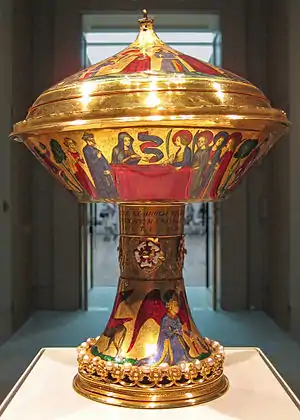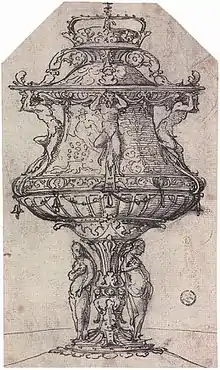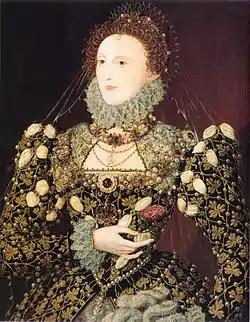Inventory of Elizabeth I
The Jewels and Plate of Queen Elizabeth I: The Inventory of 1574 was published from manuscripts by Arthur Jefferies Collins in 1955. The published inventory describes jewels and silver-plate belonging to Elizabeth I with detailed references to other source material.
Introduction
The sources used by Collins were British Library Harley MS 1560 and Stowe MS 555. The manuscripts represent the "Quenis Majesties juelles plate and other stuff" in 1574 and additions by gift or purchase over the next 20 years which were kept in the Jewel House at the Tower of London. Collins also collated information from other books and manuscripts to cross-reference information about the objects listed. Gifts of plate to the queen passed from the Privy Chamber to the Jewel House. Some pieces were melted down and others were given as diplomatic gifts. When the queen travelled, the towns she visited often gave her gifts of silver-gilt cups.
In 1574 the office of the Jewel House was located in a two-storey building on the south side of the White Tower. This contained the records of the jewels and packing materials for sending jewels to court.[1] The 1574 inventory was made John Astley, Master and Treasurer of the Jewel House. The Master had an annual salary of £50 and was able to exact payments from goldsmiths appointed to work for the Jewel House, and those who transported plate from the House to diplomats. The post was lucrative, but some of the perquisites of the role were exaggerated or overstated by Sir Gilbert Talbot, who was made Master in 1660 and in 1680 wrote a treatise entitled Of the Jewel house.[2]
In the inventory the items were listed in categories; below an outline of the main categories is given with some examples of the 1,605 entries.
Other inventories of the Queen's jewels
On 12 January 1604 the goldsmiths William Herrick and John Spilman were asked to assess and make an inventory of jewels that had belonged to Queen Elizabeth. King James had already given many pieces to the queen, Princess Elizabeth, and Arbella Stuart and others. The remaining jewels had been transferred from the keeping of Mrs Mary Radcliffe or Ratcliffe, former gentlewoman to Queen Elizabeth, to the Countess of Suffolk.[3] A list of jewels in the possession of Anne of Denmark in 1606 was published by Diana Scarisbrick.[4] During the reign of James other lists of jewels were made, including those annexed to the crown in 1606, and those sent to Spain in 1623 at the time of the Spanish Match. These were printed in Thomas Rymer's Foedera.
In December 1607 Spilman, Herrick, and the goldsmith John Williams were asked to polish and amend some pieces that Queen Elizabeth had mortgaged, and King James gave Anna of Denmark a cup made of unicorn horn, a gold ewer, a salt with a branch from which serpent's tongues and sapphires were suspended, and a crystal chess board with crystal and topaz chessmen.[5] The unicorn horn cup, the ewer, and the gold salt were listed in the inventory of Anna of Denmark.[6]
Outline of the 1574 inventory
Gold plate
- Juelles of Golde
- no. 1 The imperial crown of England.
- no. 2 The sceptre of gold with a dove.
- no. 3 The globe or round ball (orb) with a cross.
- no. 4 The queen's crown (intended for a queen consort).
- no. 5 The queen's sceptre (intended for a queen consort).
- no. 6 A pair of bracelets with six rubies and seven large pearls and five smaller pearls, with red laces.[7]
- Cups and bowls

- no. 48 The St Agnes cup. A cup of gold with imagery the knop a crown imperial and about border of the cover and the foot a crown garnished with 61 pearls.[8]
- no. 49 A jewelled gold cup given to James VI of Scotland at the christening of Prince Henry at Stirling Castle on 30 August 1594.[9]
- no. 75 A cup of "assaye" of gold fair wrought and enamelled. Given to Christian IV of Denmark on 5 August 1606.[10]
- Candlesticks
- no. 77: Four gold candlesticks for a table with "H" and "R" enamelled in red. Three were gifts to Henry VIII from Catherine of Aragon.[11]
- Goblets and jugs
- Salt cellars
- no. 83 A salt called the "Morris Dance" decorated with precious stones and pearls with 5 morris dancers, a drummer, and a lady. The salt was taken to The Hague in October 1625 by the Duke of Buckingham and pawned.[12]
- Orange-strainers
- Trenchers
- Spoons and forks
- Basins, ewers and lairs
- no. 125 A gold basin with the arms of Jane Seymour with gold roses enamelled red and white, and the border of the cover engraved with roses, a bird with a ring in its mouth, and a worm or serpent. Presented to the Constable of Castile in 1604.[13]
- Glasses
- Casting-bottles
- no. 148 A casting bottle with the queen's arms. Dorothea Silking, a servant of Anne of Denmark was accused of taking this bottle.[14]
Silver, silver-gilt, and parcel-gilt plate
- Crosses
- Book-covers
- nos. 152 and 153 The covering of a Bible of silver and gilt fair wrought, and the covering of a Book of Common Prayer. These book covers were later weighed by the auditor Francis Gofton.[15]
- A baptismal font
- no. 159 The silver-gilt font was decorated with pomegranates (the emblem of Catherine of Aragon), roses, and "antique" (renaissance style) decoration. It was made for Mary I of England in 1555.[16]
- Church plate
- Mitres
- Cups and cups of assay
- no. 215 An "Antique" (renaissance style) gilt cup with a cover with a letter "D". Given in 1604 to Jean Grusset Richardot, President of the Privy Council of the Netherlands.[17]
- no. 225 Two great gilt cups with German knights in armour on their covers with shields and halberds. These had belonged to the Duke of Northumberland. With other pieces, they were given to Alessandro Roveda, a Spanish representative at the Somerset House Conference on 22 August 1604.[18]
- no 356 A cup called a "colloke" made of serpentine with a silver-gilt cover, given by Sir John Mason as a New Year's gift in 1562. The silver was sent to the mint to be made into coin in 1600.[19]
- Bowls
- Bowls (gilt)
- Bowls (parcel-gilt and silver)
- Pots (gilt)
- Pots (parcel-gilt and silver)
- no. 539 Two gilt pots with rings around their bellies and angels and ciphers (initials) around their necks. Given to Juan Fernández de Velasco, 5th Duke of Frías, Constable of Castile, in August 1604 at the Somerset House Conference.[20]
- Flagons and casting bottles (gilt)
- Flagons of glass or stone bound in velvet
- Spice plates
- Spice boxes
- Candlesticks and snuffers
- Spoons
- Goblets and glasses
- Jugs
- Tankards and Hanse pots
- Cruises (A type of tankard)
- Stoneware jugs
- Salt cellars
- no. 998 A basin of silver-gilt designed by Hans Holbein the younger for Anne Boleyn.[21]Declared unserviceable and sold in 1620.[22]
 The table fountain designed by Holbein for Anne Boleyn was item no. 998 in the 1574 inventory
The table fountain designed by Holbein for Anne Boleyn was item no. 998 in the 1574 inventory
- no. 998 A basin of silver-gilt designed by Hans Holbein the younger for Anne Boleyn.[21]
- Basins, fountains, ewers and gilt lairs (a lair was a kind of ewer)
- Basins and ewers (parcel-gilt and silver)
- Chafing dishes
- Trenchers
- Knives
- 'Vessell' (gilt, parcel-gilt and silver)
- Kitchen plate
- no. 1305 An instrument of silver to roast puddings and apples. Melted down for coinage in October 1600.
- Orange strainers
- no. 1314 A strainer for oranges with a long steel writhen pole.[23]
- no. 1320 A strainer for oranges of silver and gilt with two crystals in the handle, given by Sir George Howard, Master of the Armouries, in 1573.[24]
- Perfume pans
- no. 1322 A perfume pan of silver and gilt with pillars of crystal part broken, and a clock plated with gold and enamelled. Melted down in October 1600.[25]
"Sundry parcelles"
- no. 1375 A gunpowder flask taken from the body of James IV at the Battle of Flodden.[26]
Plate received on 10 January 1574 from the grooms of the Privy Chamber
- no. 1398 A cup of gold with cover holding an escutcheon given by the townsmen of Sandwich on 31 August 1573.
Accessions in 1577
- no. 1429 Thirteen hooks of silver gilt made to fasten hangings in the queen's privy chamber, placed in the keeping of Dorothy Habington, the sister of Edward Habington.[27]
- no. 1433 Four gold toothpicks given by Mistress Elizabeth Snowe, gentlewoman in the Privy Chamber.[28]
- no. 1440 A cup of agate set with rubies and emeralds given by Thomas Wilson, and delivered to Jewel House from the Privy Chamber by Henry Middlemore, groom of the privy chamber, the father of Mary Middlemore a maid of honour to Anna of Denmark.[29]
- no. 1453 A jug of crystal with silver gilt with a phoenix at the top given by Lord Henry Seymour. Anna of Denmark had this jug during her lying-in pregnant with Princess Sophia.[30]
Additions recorded to 12 August 1594
- no. 1483 Three gilt bowls with covers given by the town of Yarmouth in August 1578. Elizabeth did not visit the town because of an outbreak of plague.
- no. 1484 A fair standing bowl with a silver cover decorated with scenes of the story of Joseph given by the members of the Dutch church in Norwich on 19 August 1578.
- no. 1485 A cup with a cover of silver gilt given by the town of Thetford in August 1578.[31]
- no. 1515 A basket of silver to use to clear away dining utensils, presented by Francis Drake at a banquet at Deptford in 1581.[32]
- no. 1521 A double porringer and 4 silver boxes with silver gilt covers given by Blanche Parry.[33]
- no. 1541 A great standing cup gilt, with a cover, the body garnished with "sundry vermin as snakes ewetes (newts) frogs and others", and laid with colours, the cover garnished with sundry men and beasts hunting with a stag at the top, supplied by Alderman Martin. This cup, probably made in Germany, was admired in the Tower of London by Lupold von Wedel in November 1584. It was a gift at the baptism of Prince Henry in August 1594.[34]
References
- Collins, pp. 3, 35.
- Collins, pp. 223–5: Archaeologia, XII, pp. 115–23: British Library Add. 34359: Several other copies of Talbot's treatise survive in manuscript.
- Mary Anne Everett Green, Calendar State Papers James I: 1603-1610 (London, 1857), p. 66 citing TNA SP14/6/9.
- Diana Scarisbrick, 'Anne of Denmark's Jewellery Inventory', Archaeologia, vol. CIX (1991), pp. 193–237. The manuscript is kept by the National Library of Scotland.
- Frederick Devon, Issues of the Exchequer during the Reign of James I (London, 1836), pp. 305-6.
- Diana Scarisbrick, 'Anne of Denmark's Jewellery Inventory', Archaeologia, vol. CIX (1991), pp. 193–237, at p. 236.
- Collins, pp. 264–267.
- Collins, pp. 279–281.
- Collins, pp. 281.
- Collins, p.287
- Collins, pp.287-8
- Collins, p.289-90
- Collins, pp. 300-1.
- Collins, p.306
- Collins, p. 308.
- Collins, p. 310.
- Collins, p. 323.
- Collins, p.325.
- Collins, p. 350.
- Collins, p.380.
- Collins, pp. 468–469.
- Thomas Rymer, Foedera, vol. 7 part 3 (Hague, 1739), pp. 130, 132.
- Collins (1955), p. 526.
- Collins (1955), p. 527.
- Collins (1955), p. 527.
- Collins, pp. 538–239.
- Collins, p. 551.
- Collins, p. 552.
- Collins, p. 553.
- Collins, pp. 140, 557.
- Collins, p. 565.
- Collins, pp. 572-3.
- Collins, p. 575.
- Collins, p. 578.
Bibliography
- Collins, Arthur Jefferies (1955). Jewels and Plate of Queen Elizabeth I: The Inventory of 1574. Trustees of the British Museum. ASIN B0006EIQUG.
- Keay, Anna (2011). The Crown Jewels: The Official Illustrated History. Thames & Hudson. ISBN 978-0-500-51575-4.
